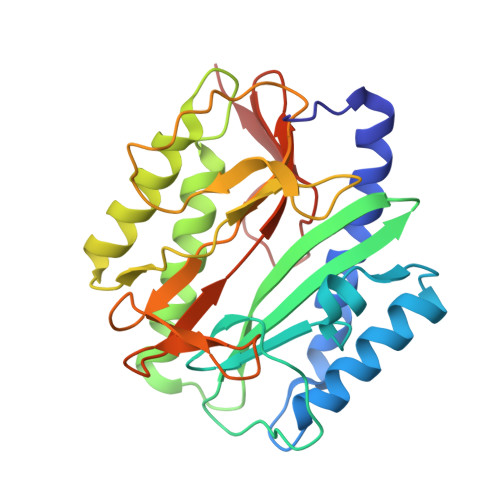Insights into the mechanism of Escherichia coli methionine aminopeptidase from the structural analysis of reaction products and phosphorus-based transition-state analogues.
Lowther, W.T., Zhang, Y., Sampson, P.B., Honek, J.F., Matthews, B.W.(1999) Biochemistry 38: 14810-14819
- PubMed: 10555963
- DOI: https://doi.org/10.1021/bi991711g
- Primary Citation of Related Structures:
1C21, 1C22, 1C23, 1C24, 1C27 - PubMed Abstract:
In an effort to differentiate between alternative mechanistic schemes that have been postulated for Escherichia coli methionine aminopeptidase (eMetAP), the modes of binding of a series of products and phosphorus-based transition-state analogues were determined by X-ray crystallography. Methionine phosphonate, norleucine phosphonate, and methionine phosphinate bind with the N-terminal group interacting with Co2 and with the respective phosphorus oxygens binding between the metals, interacting in a bifurcated manner with Co1 and His178 and hydrogen bonded to His79. In contrast, the reaction product methionine and its analogue trifluoromethionine lose interactions with Co1 and His79. The interactions with the transition-state analogues are, in general, very similar to those seen previously for the complex of the enzyme with a bestatin-based inhibitor. The mode of interaction of His79 is, however, different. In the case of the bestatin-based inhibitor, His79 interacts with atoms in the peptide bond between the P(1)' and P(2)' residues. In the present transition-state analogues, however, the histidine moves 1.2 A toward the metal center and hydrogen bonds with the atom that corresponds to the nitrogen of the scissile peptide bond (i.e., between the P(1) and P(1)' residues). These observations tend to support one of the mechanistic schemes for eMetAP considered before, although with a revision in the role played by His79. The results also suggest parallels between the mechanism of action of methionine aminopeptidase and other "pita-bread" enzymes including aminopeptidase P and creatinase.
- Institute of Molecular Biology, Howard Hughes Medical Institute and Department of Physics, 1229 University of Oregon, Eugene, Oregon 97403, USA.
Organizational Affiliation:



















